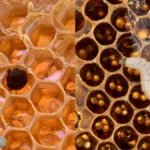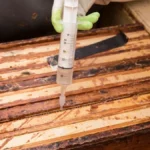In this article, we have a look at chalkbrood and how to deal with it. This fungal pathogen of bees is a minor nuisance most of the time, but when there is a flare-up, you do need to do something about it. Chalkbrood treatment is a combination of genetic management and good housekeeping.
What Is Chalkbrood Disease?
Before we can look at chalkbrood treatment, we must understand what caused chalkbrood disease in bees.
The Causative Agent Of Chalkbrood Disease In Bees
Chalkbrood is caused by the honeybee pathogenic fungus, Ascosphaera apis. During the early stage of larval development, when the larvae are floating in royal jelly, and then later being fed pollen, the spores of the fungus get ingested. The fungus then grows rapidly inside the bee and produces a hard lump of mycelia. It consumes the bee and turns it into what looks like a lump of chalk.
In order to understand this, we need to delve a little into how a simple fungus-like Ascosphaera apis works.
Understanding The Fungal Lifecycle Of Ascosphaera Apis
The cycle starts when an ascospore germinates. This ascospore produces a fungus that will then mate with an opposite mating type. The mated fungus grows aggressively and consumes the nutrients available to it, and then forms ascospores again. This fungus produces its ascospores in a weird and unique structure called a sporocyst. When it does this, the mycelial mass changes from being a white colour to being dark.
What Happens When You Get An Outbreak Of Chalkbrood In Bees?
Typically, when we get chalkbrood disease in bees, we will find that the brood will have open cells with white, or sometimes black, mummies of the bees in them. These are dead bees that have been completely consumed by fungus.
When the chalkbrood goes black, it produces ascospores, which will then infect the cell, and the next larvae to grow in that cell will get infected with chalkbrood as well.
What Do Bees Do About Chalkbrood?
Depending on the genetics of your bees, they will clean infected cells out with a greater or lesser degree of enthusiasm. The faster the infected mummies (what we call larvae that have been turned into a lump of chalky fungus) are removed, the less likely they will produce ascospores. The fewer spores the lower the chances of larvae being infected with the chalkbrood disease.

Chalkbrood Treatment
Requeen with better more hygienic genetics. In this article, we discuss requeening. If you look at the hygienic strains of bees, they remove mummies quickly. There is also evidence to suggest that chalkbrood resistant strains may feed their larvae more royal jelly.
There are no widely available treatments for chalkbrood. In my opinion, genetic selection of resistant strains of bees, together with good hive ventilation is the best management strategy.
There are however some clever new products under development. Other pathogens such as the varroa mite and the tracheal mite weaken bees and make them more susceptible to infection with chalkbrood. We have looked at how bees breathe – the tracheal mite infects the tracheae, and creates additional routes of infection in the bees.
This product uses a bacterial pathogen that infects the varroa and tracheal mites and also inhibits chalkbrood.

On Varroa Mite and Chalkbrood
There is a strong association with the increased prevalence of chalkbrood in beehives infected with the varroa mite. Part of chalkbrood treatment therefore involves varroa management.
I remember when varroa mite first arrived in my area. We had hardly ever seen chalkbrood before, but as soon as the mite arrived we would suddenly find that entire apiaries would have brood frames where huge numbers of cells were infected with chalkbrood.
Many people have likened Varroa mites in bees to Aids in humans. The association is not really very scientific, but the observation is true. In HIV-Aids, the immune system weakens, and people get infected with all sorts of diseases that would not normally kill a person.
In honeybees, a big part of the actual immune system of the bees is its thick cuticle and exoskeleton. The “skin” of the bee basically keeps things out. If pathogens get inside the bee, its immune system is quite weak, and easily overwhelmed.
The varroa mite makes holes in the layer separating the inside of the bee from the world. Pathogens flow through these holes and the bees are doomed.
Re-emphasizing The Importance Of Genetics
Bees that have an element of varroa resistance will also tend to have some resistance to chalkbrood. Maintaining healthy apiaries, and increasing the genetics in your apiary, so that it can adapt, and evolve to be suited to your conditions is an important part of managing your beekeeping.
We have a closer look at this here.
My Personal Experience With Genetics and Varroa/Chalkbrood
In the area I was first exposed to chalkbrood and varroa I was keeping Apis mellifera capensis at the time. These bees are quite difficult bees to manage and have a very high genetic diversity. When varroa arrived, the impact of the mite was terrible.
We would see heaps of dead bees in front of the hive – in the morning, it looked like the bottom of a chalkboard in a math class – there were so many chalky bee mummies lying in front of the hive. The bees would cart these away. The Cape bee is quite hygienic and actively removes the chalkbrood mummies.
Adaptation
Over a period of three years, a big change occurred. We saw less and less chalkbrood and fewer varroa mites in the hives. Somehow, a strain of bees emerged which was resistant to these pathogens. At the outset of the varroa invasion, drones were hardly ever seen flying.
Now, 14 years later, if you go to a beehive in spring you see thousands of drones flying, and queens can mate with varroa and chalkbrood resistant drones.
The important lesson here is that Apis mellifera capensis is basically an unmanaged bee. People do not requeen with bought queens. The genetic diversity is huge, and bees could adapt to pathogens.
In the rest of the world, the genetic diversity is not as great, and the only way you will get this is by actively bringing in queens from as many different breeders as possible and mixing it up, and letting your bees rear their own locally adapted queens from this starter genetic bank.
We hope this article has helped you understand chalkbrood treatment and how to manage chalkbrood in bees. Please spread the message about the importance of genetic diversity in managing chalkbrood disease in bees. The easiest form of chalkbrood treatment is if you don’t have to!
Read more about: How To Get Rid Of Wax Moths In Beehives
Bee Hive Chalkbrood FAQs
What is chalkbrood?
- Chalkbrood is a fungal disease affecting honeybee larvae, caused by the fungus Ascosphaera apis. Infected larvae turn into chalky mummies.
How does chalkbrood affect bee colonies?
- While usually a minor nuisance, chalkbrood can lead to increased mortality in larvae, weakening the overall health of the colony during outbreaks.
What are the signs of a chalkbrood outbreak?
- Signs include open brood cells containing white or black mummies of larvae, which are evidence of fungal infection.
How can I treat chalkbrood in my hive?
- Treatment focuses on genetic management, including requeening with hygienic bee strains, ensuring good hive ventilation, and controlling varroa mite populations.
Is there a chemical treatment for chalkbrood?
- Currently, there are no widely accepted chemical treatments for chalkbrood. Management relies on genetic selection and best beekeeping practices.
What role do varroa mites play in chalkbrood outbreaks?
- Varroa mites weaken bees and make them more susceptible to infections like chalkbrood. Managing varroa populations is crucial in preventing chalkbrood.
How can genetics help in managing chalkbrood?
- Breeding bees with hygienic behavior can improve removal of infected larvae and reduce the likelihood of chalkbrood outbreaks.
Can chalkbrood be completely eliminated from my apiary?
- While it may not be completely eliminated, effective management practices can significantly reduce its occurrence and impact.
What is the lifecycle of the chalkbrood fungus?
- The lifecycle of Ascosphaera apis includes spore germination, fungal growth, and production of new spores, which can reinfect bee larvae.
How can I prevent chalkbrood in my hives?
- Maintaining strong colonies, selecting for hygienic genetics, and implementing good hive management practices can help prevent chalkbrood.

Dr. Garth A. Cambray is a Canadian/South African entrepreneur and beekeeper with 28 years of experience in apiculture and specializes in adding value to honey. His Ph.D. research developed a new advanced continuous fermentation method for making mead that has resulted in a number of companies globally being able to access markets for mead. His company, Makana Meadery, exports honey mead to the USA where it is available to discerning connoisseurs. He has also developed technologies to commercially manufacture organic honey vinegar in Zambia for export globally. He holds a few patents globally in the ethanol industry and believes in technology and knowledge transfer for human development and environmental sustainability. One of his proudest achievements is the fact that the wind farm he started at one of his old apiary sites has essentially made his hometown carbon neutral.






